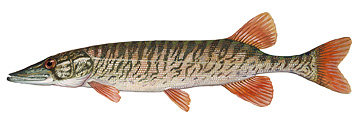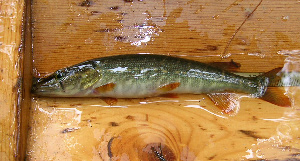Redfin Pickerel
Esox americanus
 Distribution: Redfin pickerel are native to the Atlantic coastal plain and reach the northern extent of their range in New Hampshire. There are a few isolated populations in Maine, where the species is listed as State Endangered. In New Hampshire, the species is restricted to lower elevation rivers and streams along the coastal plain in the lower Merrimack and southern coastal drainages.
Distribution: Redfin pickerel are native to the Atlantic coastal plain and reach the northern extent of their range in New Hampshire. There are a few isolated populations in Maine, where the species is listed as State Endangered. In New Hampshire, the species is restricted to lower elevation rivers and streams along the coastal plain in the lower Merrimack and southern coastal drainages.
Description: Redfin pickerel look similar to the chain pickerel, except smaller, with a more blunt snout and an olive to yellowish green coloration compared to the deeper green color of the chain pickerel. Its most distinctive features are its reddish colored fins and a backwards slanting black vertical bar beneath the eye.
Species commonly confused with: Chain pickerel
Habitat: The redfin pickerel prefers shallow weedy backwaters in stands of aquatic vegetation or thick overhanging grasses and shrubs. It is often found in smaller watersheds than the chain pickerel. In New Hampshire it is frequently found in streams flowing through abandoned beaver ponds in very small watersheds that may dry up in some years.

Life History: Redfin pickerel are the smallest member of the pike family, attaining a maximum length of about 12 inches. Redfin pickerel spawn in early spring by laying strings of eggs over vegetation or submerged branches in shallow water. Its prey consists of invertebrates and small fish. Redfin pickerel appear to be well adapted to living in headwater stream habitat and have been captured in surprisingly small streams with very low flow.
Origin: Native
Conservation/Management: Although redfin pickerel are relatively common in southern New England, populations in New Hampshire are limited to the southeastern corner of New Hampshire where aquatic habitats are rapidly becoming degraded due to increasing development pressure.



